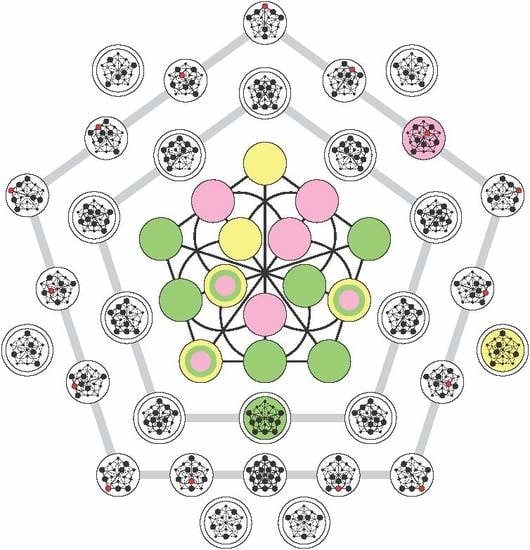Magic Three-Qubit Veldkamp Line and Veldkamp Space of the Doily
Abstract
:1. Introduction
2. Basic Glossary
3. Veldkamp Space of the Doily
4. Three Off-Doily Sectors of the Magic Veldkamp Line and the Doily’s Veldkamp Space
4.1. Grids and Hyperbolic Sector
4.2. Ovoids and Elliptic Sector
4.3. Perp-Sets and Parabolic Sector
4.4. Sectors Image of the Doily’s Veldkamp Space
5. Towards Parapolar Spaces
Author Contributions
Funding
Acknowledgments
Conflicts of Interest
References
- Holweck, F. Geometric constructions over and for quantum information. In Quantum Physics and Geometry; Ballico, E., Bernardi, A., Carusotto, I., Mazzucchi, S., Moretti, V., Eds.; Lecture Notes of the Unione Matematica Italiana; Springer Nature: Cham, Switzerland, 2019; Volume 25, pp. 87–124. [Google Scholar]
- Keppens, D. On the history of ring geometry (with a thematical overview of literature). Mitt. Math. Ges. Hambg. 2019, 39, 99. [Google Scholar]
- Planat, M.; Saniga, M. On the Pauli graph of N-qudits. Quantum Inf. Comput. 2008, 8, 127. [Google Scholar]
- Lévay, P.; Holweck, F.; Saniga, M. The magic three-qubit Veldkamp line: A finite geometric underpinning for form theories of gravity and black hole entropy. Phys. Rev. D 2017, 96, 026018. [Google Scholar] [CrossRef] [Green Version]
- Lévay, P.; Szabó, Z. Mermin pentagrams arising from Veldkamp lines for three qubits. J. Phys. Math. Theor. 2017, 50, 095201. [Google Scholar] [CrossRef] [Green Version]
- Saniga, M. A combinatorial Grassmannian representation of the magic three-qubit Veldkamp line. Entropy 2017, 19, 556. [Google Scholar] [CrossRef] [Green Version]
- Lévay, P.; Saniga, M.; Vrana, P.; Pracna, P. Black hole entropy and finite geometry. Phys. Rev. D 2009, 79, 084036. [Google Scholar] [CrossRef] [Green Version]
- Borsten, L.; Duff, M.J.; Lévay, P. The black-hole/qubit correspondence: An up-to-date review. Class. Quantum Gravity 2012, 29, 224008. [Google Scholar] [CrossRef] [Green Version]
- Green, R.M. Combinatorics of Minuscule Representations. Cambridge Tracts in Mathematics, 199; Cambridge University Press: Cambridge, UK, 2013. [Google Scholar]
- Payne, S.E.; Thas, J.A. Finite Generalized Quadrangles; Pitman: Boston, MA, USA, 1984. [Google Scholar]
- Van Maldeghem, H. Generalized Polygons; Birkhäuser: Basel, Switzerland, 1998. [Google Scholar]
- Cameron, P.J. Projective and Polar Spaces. QMW Maths Notes, 13; School of Mathematical Sciences, Queen Mary and Westfield College: London, UK, 1992. [Google Scholar]
- Buekenhout, F.; Cohen, A.M. Diagram Geometry: Related to Classical Groups and Buildings; Springer: Berlin, Germany, 2013. [Google Scholar]
- Saniga, M.; Planat, M.; Pracna, P.; Havlicek, H. The Veldkamp space of two-qubits. Symmetry Integr. Geom. Methods Appl. 2007, 3, 75. [Google Scholar] [CrossRef]
- Saniga, M.; Lévay, P.; Planat, M.; Pracna, P. Geometric hyperplanes of the near hexagon L3×GQ(2,2). Lett. Math. Phys. 2010, 91, 93. [Google Scholar] [CrossRef] [Green Version]
- Polster, B. A Geometrical Picture Book; Springer: New York, NY, USA, 1991. [Google Scholar]
- Cooperstein, B.N. A characterization of some Lie incidence structures. Geom. Dedicata 1977, 6, 205. [Google Scholar] [CrossRef]
- Shult, E.E. Points and Lines: Characterizing the Classical Geometries; Universitext; Springer: Berlin/Heidelberg, Germany, 2011. [Google Scholar]
- Kasikova, A.; Shult, E.E. Point-line characterizations of Lie incidence geometries. Adv. Geom. 2002, 2, 147. [Google Scholar] [CrossRef] [Green Version]
- Cohen, A.M.; Cooperstein, B.N. A characterization of some geometries of exceptional Lie type. Geom. Dedicata 1983, 15, 73. [Google Scholar] [CrossRef] [Green Version]
- Schillewaert, J.; Van Maldeghem, H. On the varieties of the second row of the split Freudenthal–Tits magic square. Ann. Inst. Fourier 2017, 67, 2265. [Google Scholar] [CrossRef] [Green Version]
- Holweck, F.; Saniga, M.; Lévay, P. A notable relation between N-qubit and 2N−1-qubit Pauli groups via binary LGr(N,2N). Symmetry Integr. Geom. Methods Appl. 2014, 10, 41. [Google Scholar] [CrossRef] [Green Version]


© 2020 by the authors. Licensee MDPI, Basel, Switzerland. This article is an open access article distributed under the terms and conditions of the Creative Commons Attribution (CC BY) license (http://creativecommons.org/licenses/by/4.0/).
Share and Cite
Saniga, M.; Szabó, Z. Magic Three-Qubit Veldkamp Line and Veldkamp Space of the Doily. Symmetry 2020, 12, 963. https://doi.org/10.3390/sym12060963
Saniga M, Szabó Z. Magic Three-Qubit Veldkamp Line and Veldkamp Space of the Doily. Symmetry. 2020; 12(6):963. https://doi.org/10.3390/sym12060963
Chicago/Turabian StyleSaniga, Metod, and Zsolt Szabó. 2020. "Magic Three-Qubit Veldkamp Line and Veldkamp Space of the Doily" Symmetry 12, no. 6: 963. https://doi.org/10.3390/sym12060963
APA StyleSaniga, M., & Szabó, Z. (2020). Magic Three-Qubit Veldkamp Line and Veldkamp Space of the Doily. Symmetry, 12(6), 963. https://doi.org/10.3390/sym12060963






